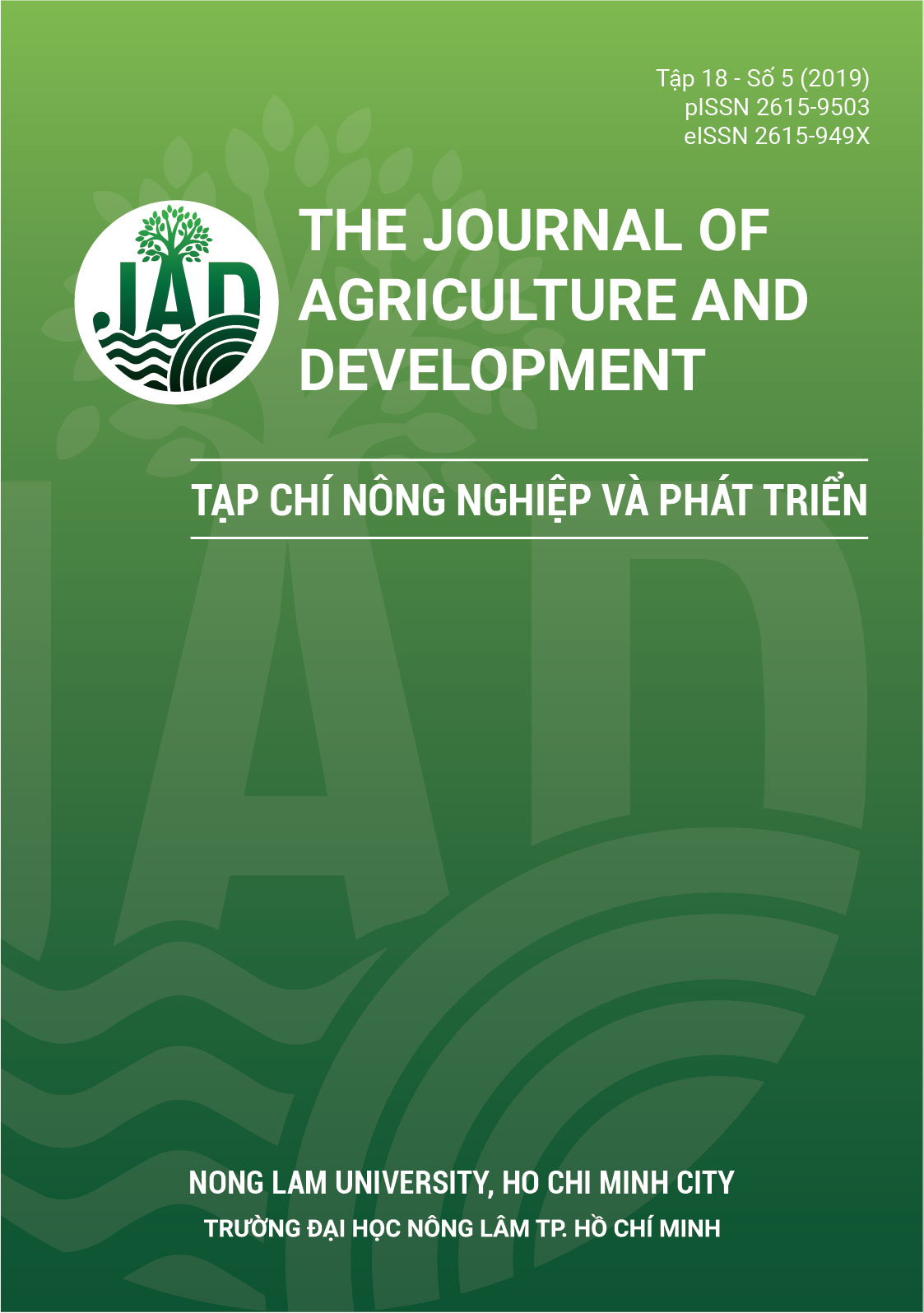Đánh giá thành phần hóa học và tác dụng ức chế sự nảy mầm và phát triển của hạt cỏ lồng vực (Echinochloa crus-galli L.) từ cao chiết cây bồ công anh (Hypochaeris radicata L.)
Main Article Content
Tóm tắt
Sự ức chế cảm nhiễm (allelopathy) là một cơ chế đối kháng thực vật phổ biến trong tự nhiên, cơ chế này thể hiện khi sự phát triển của loài thực vật này có thể ảnh hưởng đến sự sinh trưởng và phát triển các loài thực vật lân cận thông qua việc sản sinh các hợp chất thứ cấp. Trong nghiên cứu này, khả năng kháng cỏ lồng vực (CLV) của cao chiết ethanol từ cây bồ công anh (BCA) được khảo sát trong điều kiện phòng thí nghiệm. Kết quả khảo sát cho thấy, tại nồng độ 5 mg/mL cao chiết của thân BCA có tác dụng ức chế nảy mầm hạt CLV cao nhất là 73,3%. Bên cạnh đó, hàm lượng polyphenol và flavonoid tổng số trong cây BCA được xác định bằng phương pháp đo quang phổ. Các hợp chất polyphenol và flavonoid có trong tất cả các bộ phận của cây được khảo sát. Hàm lượng polyphenol cao nhất trong lá là 9,67 mg/mL cao, flavonoid có hàm lượng nhiều nhất trong rễ là 29,56 mg/mL cao. Mẫu cao chiết từ các bộ phận cây BCA cũng được sử dụng để định tính các acid phenolic bằng phương pháp HPLC. Có bảy loại acid phenolic hiện diện trong các mẫu cao chiết BCA, đó là chlorogenic, syringic, vanillic, synapic, p-coumaric, benzoic và ellagic. Từ các số liệu cho thấy BCA là một loài thực vật hoang dại rất có tiềm năng trong nghiên cứu về các hợp chất tự nhiên có hoạt tính kháng cỏ.
Article Details
Tài liệu tham khảo
Abu-Romman, S. (2016). Differential allelopathic expression of different plant parts of Achillea biebersteinii. Acta Biologica Hungarica 67(2), 159-168. https://doi.org/10.1556/018.67.2016.2.4
Balicevic, R., & Ravlic, M. (2015). Allelopathic effect of scentless mayweed extracts on carrot. Herbologia 15(1), 11-18. https://doi.org/10.5644/Herb.15.1.02
Cameron, H. J., & Julian, G. R. (1980). Inhibition of protein synthesis in lettuce (Latuca sativa L.) by allelopathic compounds. Journal of Chemical Ecology 6(6), 989-995. https://doi.org/10.1007/BF00994656
Chung, I. M., Kim, J. T., & Kim, S. H. (2006). Evaluation of allelopathic potential and quantification of momilactone A, B from rice hull extracts and assessment of inhibitory bioactivity on paddy field weeds. Journal of Agricultural and Food Chemistry 54(7), 2527-2536. https://doi.org/10.1021/jf052796x
Dewanto, V., Wu, X., Adom, K. K., & Liu, R. H. (2002). Thermal processing enhances the nutritional value of tomatoes by increasing total antioxidant activity. Journal of Agricultural and Food Chemistry 50(10), 3010-3014. https://doi.org/10.1021/jf0115589
Ilori, O. J., Otusanya, O. O., Adelusi, A. A., & Sanni, R. O. (2010). Allelopathic activities of some weeds in the Asteraceae family. International Journal of Botany 6(2), 161-163. https://doi.org/10.3923/ijb.2010.161.163
Jabran, K. (2017). Manipulation of allelopathic crops for weed control. Springer briefs in plant science Switzerland. Berlin, Germany: Springer.
Khang, D. T., Anh, L. H., Ha, P. T. T., Tuyen, P. T., Quan N. V., Minh, L. T., Quan N.T., Minh, T. N., Xuan, T.D., Khanh, T. D., & Trung, K. H. (2016). Allelopathic activity of dehulled rice and its allelochemicals on weed germination. International Letters of Natural Sciences 58(2), 1-10. https://doi.org/10.18052/www.scipress.com/ILNS.58.1
Kim, O. Y., Park, S. I., Jung, I. M., & Ha, S. Y. (2005). The allelopathic effects of aqueous extracts of Hypochaeris radicata L. on forage crops. Journal of Life Science 15(6), 871-878. https://doi.org/10.5352/JLS.2005.15.6.871
Li, Z. H., Qiang, W., Ruan, X., Pan, C. D., & Jiang, D. A. (2010). Phenolics and plant allelopathy. Molecules 15, 8933-8952. https://doi.org/10.3390/molecules15128933
Pejman, N., Hassan, K., Morteza, M., & Nayereh, A. S. H. (2011). Allelopathic potential of sunflower on weed management in safflower and wheat. Australian Journal of Crop Science 5(11), 1434-1440.
Thi, H. L., Lin, C. H., Smeda, R. J., Leigh, N. D., Wycoff, W. G., & Fritschi, F. B. (2014). Isolation and identification of an allelopathic phenylethylamine in rice. Phytochemistry 108, 109-121. https://doi.org/10.1016/j.phytochem.2014.08.019
Wang, R. L., Liu, S. W., Xin, X. W., Chen, S., Peng, G. X., Su, Y. J., & Song, Z. K. (2017). Phenolic acids contents and allelopathic potential of 10-cultivars of Alfalfa and their bioactivity. Allelopathy Journal 40(1), 63-70.
Weston, L. A., & Mathesius, U. (2013). Flavonoids: their structure, biosynthesis and role in the rhizosphere, including allelopathy. Journal of Chemical Ecology 39(2), 283-297. https://doi.org/10.1007/s10886-013-0248-5
Xuan, T. D., Tsuzuki, E., Terao, H., Matsuo, M., Khanh, T. D., Murayama, S., & Hong, N. H. (2003). Alfalfa, rice by-products and their incorporation for weed control in rice. Weed Biology and Management 3(2), 137-144. https://doi.org/10.1046/j.1445-6664.2003.00095.x
Zhishen, J., Mengcheng, T., & Jianming, W. (1999). The determination of flavonoid contents in mulberry and their scavenging effects on superoxide radicals. Food Chemistry 64(4), 555-559. https://doi.org/10.1016/S0308-8146(98)00102-2








